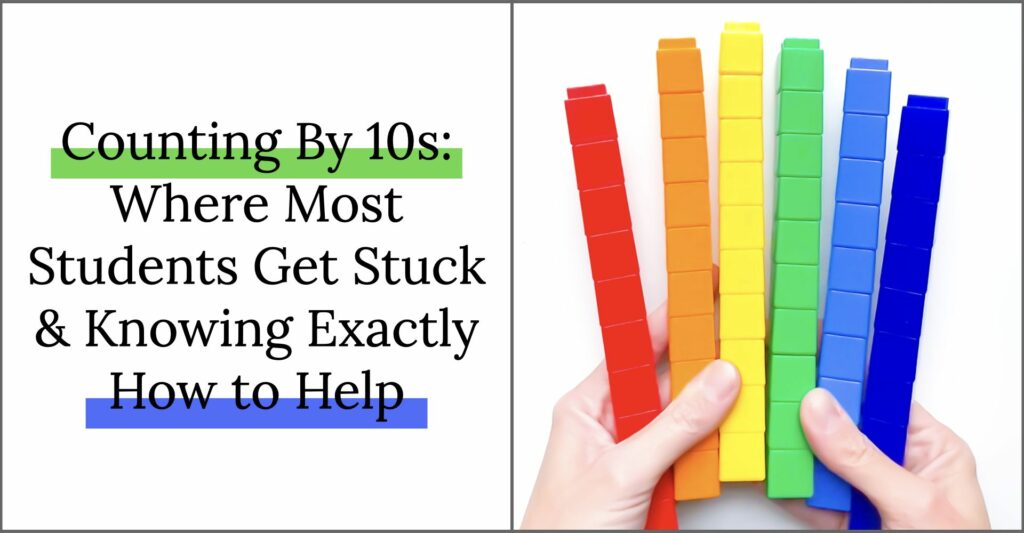
Let’s talk about counting by 10s! It’s an essential skill and one that helps build an early understanding of place value. However, it’s also a skill that is often taught before a student is ready. Students need to understand several concepts prior to counting by 10s.
Sure, a student can recite a rote sequence of numbers: 10, 20, 30, 40…etc. But for that sequence to have any meaning, there are several key understandings that need to be achieved. In this post, we’re going to break down the prerequisite skills needed for students to start counting by 10s, and then how to get them counting by 10s independently and with purpose.
Prerequisite Skills for Counting by 10s
1:1 Correspondence
1:1 correspondence is one of the earliest skills students will work towards when learning to count. Students have achieved 1:1 correspondence when they can:
- Count one object at a time
- Keep track of objects while counting
- Counts each object only once
- Understands that it doesn’t matter in which order objects are counted
Cardinality
When a student understands cardinality, they understand that the last number used to count a group of objects tells how many are in the group. There is a connection between that landing number and quantity. There is now a purpose to counting!
Understanding One More/One Less
When students can understand what is one more than 8, or one less than 5, they are beginning to understand the relationship between other numbers in the sequence. This stage is actually broken down into several components, but for the sake of this post I will leave it here.
What else is required before Counting by 10s?
Counting by 10s is essentially learning how to count groups. If a child is still trying to understand that the number they ended on when counting is “how many,” what meaning will counting by 10s have for them?
None.
It will actually prove really confusing because they are still working to count by ones and master cardinality. They will look at you sideways and tell you that you’re counting wrong because what you’re introducing will not have meaning yet.
Conservation of Number
In order to begin counting by 10s, students also need to have a firm understanding of conservation of number. What is conservation of number?
As students experience counting at various stages, they begin to develop an understanding that the number of objects remains the same, even when those objects are moved, spread out, rearranged, or some are hidden.
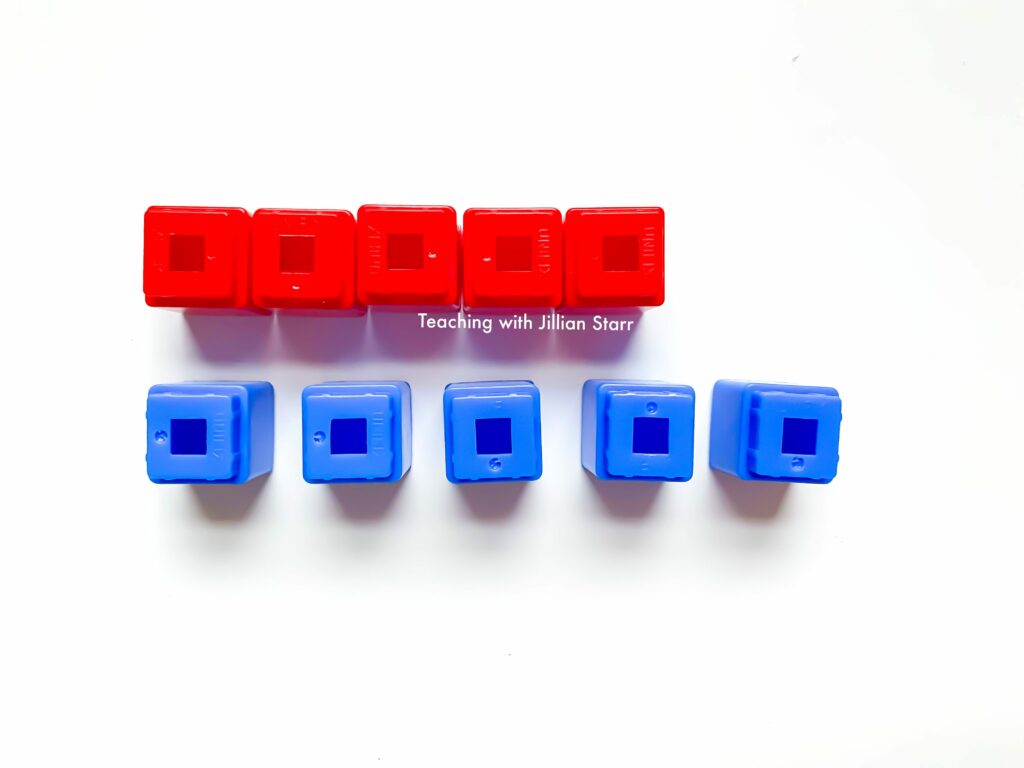
This landmark is best achieved through various experiences. Students who do not have an understanding of conservation of number will believe that the row on the bottom has more cubes, whereas students who *do* have an understanding will determine that both rows have the same amount.
In order to start counting groups, students must believe that quantity stays the same no matter how those objects are arranged. Only then will counting by 10s prove a useful strategy when counting.
How to Teach Counting by 10s?
Once our students have all of the prerequisite skills needed, we can venture into counting groups. Counting groups introduces a new concept known as unitizing.
The Concept of Unitizing
Unitizing is a huge jump for students! What is it? Well, let’s think about what students just mastered: They are now able to count single objects accurately and understand the relationship between numbers in that sequence.
We just told them that “one” means ONE object, and “two” means two objects. When we start introducing groups, we are telling students that “one” can now mean MULTIPLE objects, as in “one group of ten.” Can you see where there is a lot of room for confusion?
In order to begin counting in groups, students have to be able to see the group as one unit. This is only going to come with lots and lots of experiences.
Start with Counting by 2s
We can start by counting smaller quantities and putting them into groups of two. Some guiding questions you can ask:
- How many did you put in each group?
- Is there the same amount in each group?
- How did you count your groups?
- How many groups do you have?
- How many objects altogether do you have?
- Will that number change if we count by ones?
Giving students lots of opportunities to experience unitizing with smaller groups and smaller quantities will set them up to be successful in jumping to counting by 10s. They will start to see patterns in skip counting, and begin to understand the purpose of counting groups: it’s a faster and more efficient counting strategy.
Move into Counting by 10s
If your students can successfully unitize groups of 2, you can move into larger quantities and see if they can begin making larger groups and begin counting by 10s.
Again, provide numerous opportunities for students to experience counting by 10s with real objects. This makes for a great center! What do you need? Just some Ziploc bags and a variety of objects to place separately in each bag. Some favorite items my students loved to count include (that I already had in my classroom):
- mini erasers
- crayons
- Unifix cubes
- unit cubes (from our place value sets)
- paper clips
- pom poms
- pony beads (they loved making their groups by placing 10 at a time on pipe cleaners)
- magnetic letters
- popsicle sticks
- Q-tips
- square tiles
- 2-sided counters
This can be done independently, with partners, or even in small groups. Partnering and small groups can be especially helpful for students who are at the beginning stages of this concept. Watching peers model the process is a simple, but effective form of differentiation.
As students experience counting by 10s, it’s important that we are asking intentional questions. These can help students begin internalizing concepts and patterns they come across while counting by 10s. These might include:
- Can I hear how you counted your groups?
- How did you know what numbers to use when counting by 10s?
- Can we record the numbers you said? (teacher or student can record)
- What patterns do you notice with these numbers?
- How is counting by 10s helping you know how many objects you have?
Using Number Talks for Counting by 10s
You know I LOVE number talks! These can be a wonderful way to get students to discuss and engage with strategies for counting.
If I pull out one of the Ziploc bags and ask the class “I wonder how many ________ there are in this bag? How would you find out?”
Students can come up to the pile and demonstrate different ways of counting and organizing their piles. By sharing and witnessing a variety of methods, students can start to see which ways of counting are more accurate and efficient.
Counting by 10s as a foundation for Place Value
When our students can understand that a digit can hold multiple values (one can mean “one object” AND “one group of ten”), they can begin to understand place value. In fact, unitizing and counting by 10s set the foundation for place value!
It’s THAT important!
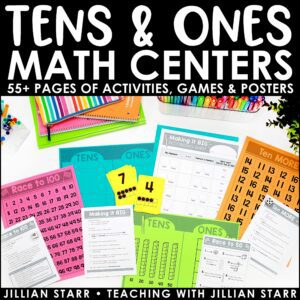
Tens and Ones Games & Activities
This very abstract concept of bundling units will be paramount to their future understanding of hundreds, tens, and ones (and beyond).
Intervention: Knowing Exactly How to Help
The amazing thing that happens when we break a skill down into subskills and prerequisite skills is that we can use that knowledge to support intervention.
If a student is struggling with counting by 10s, we know where to look! All we have to do is go back to see where they need more experience. Is it:
- 1:1 Correspondence
- Cardinality
- Knowing 1 more/1 less
- Conservation of Number
- Unitizing
- Patterns within counting by 10s
- Switching between counting 10s and 1s
A quick probe into each of these skills will tell us where our students need support, and we can create experiences to support them from there!
Remember, we don’t want to simply teach rote memorization of counting by 10s. This will not help students see counting by 10s as a strategy, but instead as a procedural task with no meaning.
Providing our students with the time and experiences to build their understanding is the best (and really only) way to internalize efficient and accurate counting strategies. It takes patience, and sometimes a deviation from the script, but it’s worth it!
If you’re looking for next steps after your students have shown mastery of counting by 10s, be sure to check out this post on Tens and Ones Activities to Teach Place Value.
You can also check out this Tens and Ones resource full of activities to add to your center rotations!

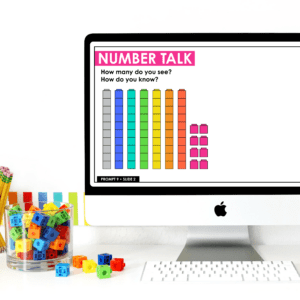
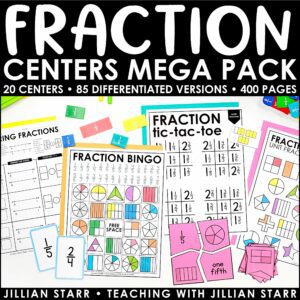
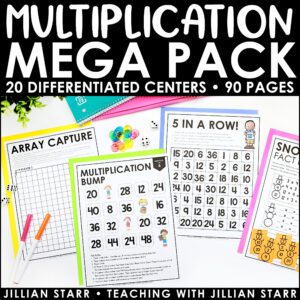
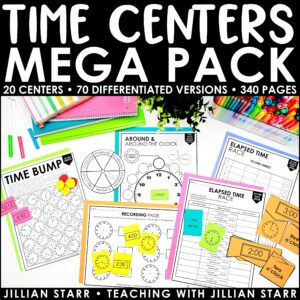
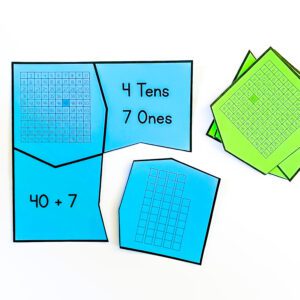
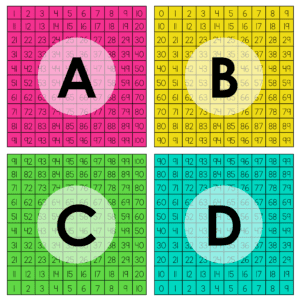
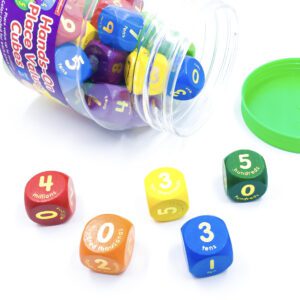


Leave a Comment